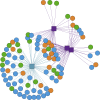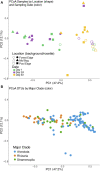Illuminating protist diversity in pitcher plants and bromeliad tanks
- PMID: 35895712
- PMCID: PMC9328516
- DOI: 10.1371/journal.pone.0270913
Illuminating protist diversity in pitcher plants and bromeliad tanks
Abstract
Many species of plants have evolved structures called phytotelmata that store water and trap detritus and prey. These structures house diverse communities of organisms, the inquiline microbiome, that aids breakdown of litter and prey. The invertebrate and bacterial food webs in these systems are well characterized, but less is known about microbial eukaryotic community dynamics. In this study we focus on microbes in the SAR clade (Stramenopila, Alveolata, Rhizaria) inhabiting phytotelmata. Using small subunit rDNA amplicon sequencing from repeated temporal and geographic samples of wild and cultivated plants across the Northeast U.S.A., we demonstrate that communities are variable within and between host plant type. Across habitats, communities from tropical bromeliads grown in a single room of a greenhouse were nearly as heterogeneous as wild pitcher plants spread across hundreds of kilometers. At the scale of pitcher plants in a single bog, analyses of samples from three time points suggest that seasonality is a major driver of protist community structure, with variable spring communities transitioning to more homogeneous communities that resemble the surrounding habitat. Our results indicate that protist communities in phytotelmata are variable, likely due to stochastic founder events and colonization/competition dynamics, leading to tremendous heterogeneity in inquiline microeukaryotic communities.
Conflict of interest statement
The authors have declared that no competing interests exist.
Figures





Similar articles
-
Selective Bacterial Community Enrichment between the Pitcher Plants Sarracenia minor and Sarracenia flava.Microbiol Spectr. 2021 Dec 22;9(3):e0069621. doi: 10.1128/Spectrum.00696-21. Epub 2021 Nov 24. Microbiol Spectr. 2021. PMID: 34817222 Free PMC article.
-
Diverse microbial communities hosted by the model carnivorous pitcher plant Sarracenia purpurea: analysis of both bacterial and eukaryotic composition across distinct host plant populations.PeerJ. 2019 Feb 18;7:e6392. doi: 10.7717/peerj.6392. eCollection 2019. PeerJ. 2019. PMID: 30805246 Free PMC article.
-
Microbial Diversity in the Eukaryotic SAR Clade: Illuminating the Darkness Between Morphology and Molecular Data.Bioessays. 2018 Apr;40(4):e1700198. doi: 10.1002/bies.201700198. Epub 2018 Mar 7. Bioessays. 2018. PMID: 29512175
-
Food webs in phytotelmata: "bottom-up" and "top-down" explanations for community structure.Annu Rev Entomol. 2001;46:729-60. doi: 10.1146/annurev.ento.46.1.729. Annu Rev Entomol. 2001. PMID: 11112185 Review.
-
The planktonic protist interactome: where do we stand after a century of research?ISME J. 2020 Feb;14(2):544-559. doi: 10.1038/s41396-019-0542-5. Epub 2019 Nov 4. ISME J. 2020. PMID: 31685936 Free PMC article. Review.
References
Publication types
MeSH terms
Grants and funding
LinkOut - more resources
Full Text Sources
Miscellaneous

